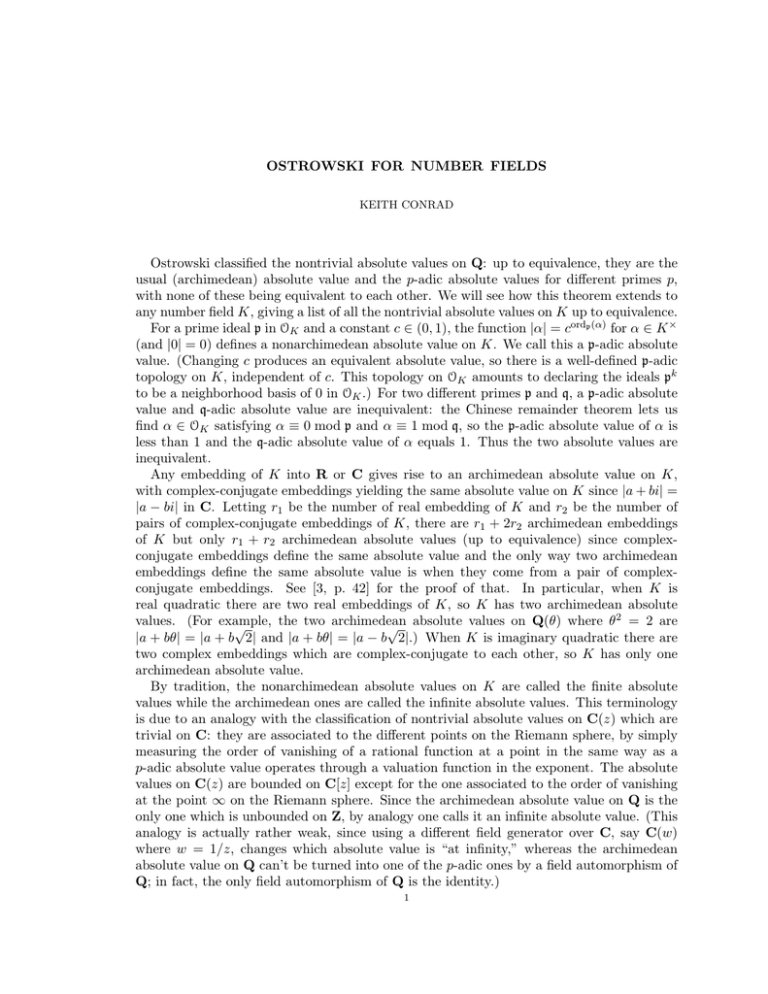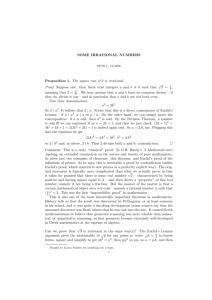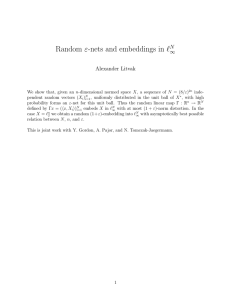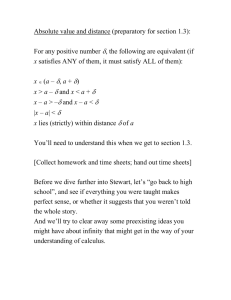OSTROWSKI FOR NUMBER FIELDS
advertisement

OSTROWSKI FOR NUMBER FIELDS
KEITH CONRAD
Ostrowski classified the nontrivial absolute values on Q: up to equivalence, they are the
usual (archimedean) absolute value and the p-adic absolute values for different primes p,
with none of these being equivalent to each other. We will see how this theorem extends to
any number field K, giving a list of all the nontrivial absolute values on K up to equivalence.
For a prime ideal p in OK and a constant c ∈ (0, 1), the function |α| = cordp (α) for α ∈ K ×
(and |0| = 0) defines a nonarchimedean absolute value on K. We call this a p-adic absolute
value. (Changing c produces an equivalent absolute value, so there is a well-defined p-adic
topology on K, independent of c. This topology on OK amounts to declaring the ideals pk
to be a neighborhood basis of 0 in OK .) For two different primes p and q, a p-adic absolute
value and q-adic absolute value are inequivalent: the Chinese remainder theorem lets us
find α ∈ OK satisfying α ≡ 0 mod p and α ≡ 1 mod q, so the p-adic absolute value of α is
less than 1 and the q-adic absolute value of α equals 1. Thus the two absolute values are
inequivalent.
Any embedding of K into R or C gives rise to an archimedean absolute value on K,
with complex-conjugate embeddings yielding the same absolute value on K since |a + bi| =
|a − bi| in C. Letting r1 be the number of real embedding of K and r2 be the number of
pairs of complex-conjugate embeddings of K, there are r1 + 2r2 archimedean embeddings
of K but only r1 + r2 archimedean absolute values (up to equivalence) since complexconjugate embeddings define the same absolute value and the only way two archimedean
embeddings define the same absolute value is when they come from a pair of complexconjugate embeddings. See [3, p. 42] for the proof of that. In particular, when K is
real quadratic there are two real embeddings of K, so K has two archimedean absolute
2
values. (For example,
the two archimedean
√ absolute values on Q(θ) where θ = 2 are
√
|a + bθ| = |a + b 2| and |a + bθ| = |a − b 2|.) When K is imaginary quadratic there are
two complex embeddings which are complex-conjugate to each other, so K has only one
archimedean absolute value.
By tradition, the nonarchimedean absolute values on K are called the finite absolute
values while the archimedean ones are called the infinite absolute values. This terminology
is due to an analogy with the classification of nontrivial absolute values on C(z) which are
trivial on C: they are associated to the different points on the Riemann sphere, by simply
measuring the order of vanishing of a rational function at a point in the same way as a
p-adic absolute value operates through a valuation function in the exponent. The absolute
values on C(z) are bounded on C[z] except for the one associated to the order of vanishing
at the point ∞ on the Riemann sphere. Since the archimedean absolute value on Q is the
only one which is unbounded on Z, by analogy one calls it an infinite absolute value. (This
analogy is actually rather weak, since using a different field generator over C, say C(w)
where w = 1/z, changes which absolute value is “at infinity,” whereas the archimedean
absolute value on Q can’t be turned into one of the p-adic ones by a field automorphism of
Q; in fact, the only field automorphism of Q is the identity.)
1
2
KEITH CONRAD
Ostrowski’s theorem for K says every nontrivial absolute value on K is equivalent to
exactly one of the absolute values we have already described, that is, p-adic for one prime
p of OK or an archimedean absolute value associated to a real or complex-conjugate pair
of embeddings. When K = Q, the proof of Ostrowki’s theorem uses special features of
OK = Z (like finite base expansions for the archimedean case and the division theorem
for the nonarchimedean case) which are not valid in number fields, so we need a different
argument to prove the theorem for K.
Lemma 1. Let p be a prime ideal in OK . If α ∈ K × and ordp (α) ≥ 0 then α = x/y where
x, y ∈ OK and ordp (y) = 0.
Proof. Write αOK = ab−1 for ideals a and b of OK with no common factors. Because
ordp (α) ≥ 0 the ideal p doesn’t divide b. Since a = (α)b, a and b lie in the same ideal class.
In any desired ideal class, it is always possible to pick an integral ideal which is relatively
prime to a given ideal. (Proof omitted; this follows from the Chinese remainder theorem on
OK .) Let c be an integral ideal in the ideal class of [a]−1 = [b]−1 which is relatively prime
to p. Then
(α) = ab−1 = ac(bc)−1 .
The ideals ac and bc are both principal. Set ac = (x) and bc = (y), so x and y are in
OK . Since b and c are both prime to p, ordp (y) = 0. Now (α) = (x)(y)−1 = (x/y), so by
rescaling x by a unit we have α = x/y with ordp (y) = 0.
The heart of the proof of Ostrowski’s theorem in the nonarchimedean case is the next
result.
Theorem 2. Let v : K × → R be a nonzero homomorphism with
(1)
v(α + β) ≥ min(v(α), v(β))
when α, β, and α + β are all in K × . Then v = t ordp for a unique prime ideal p and t > 0.
Proof. Uniqueness is easy: For a prime ideal p,
{α ∈ OK : t ordp (α) > 0} = {α ∈ OK : ordp (α) > 0} = {α ∈ OK : α ∈ p} = p.
That is, inside of OK , t ordp takes positive values precisely on p, so we can recover p from
the properties of t ordp . Since t is the smallest positive value of t ordp on K × , the value of
t is determined as well.
As for the existence of a p and t such that v = t ordp , we will show that the set
(2)
p := {α ∈ OK − {0} : v(α) > 0} ∪ {0}
is a prime ideal in OK and then we will show v = t ordp for some t > 0. Obviously this
definition for p is motivated by the calculation we made just before: if there is going to be
a prime ideal for which v is the corresponding valuation, the set in (2) has to be that ideal.
Before we even discuss p in (2), we show v(α) ≥ 0 on all nonzero algebraic integers. Since
v(1 · 1) = v(1) + v(1), v(1) = 0. Then 0 = v(1) = v((−1)2 ) = 2v(−1), so v(−1) = 0. Now by
(1), v(a) ≥ 0 for all nonzero a ∈ Z. In a sense, the nonnegativity of v on Z − {0} underlies
everything that follows. For α ∈ OK , we can write an equation of integral dependence for
it over Z, say
αn + an−1 αn−1 + · · · + a1 α + a0 = 0
with aj ∈ Z. Choose n as small as possible, so a0 6= 0. If v(α) < 0, then heuristically αn
has an n-th order pole at v, while the other terms in the sum on the left have a lower order
OSTROWSKI FOR NUMBER FIELDS
3
pole (the aj ’s don’t contribute polar data since v(aj ) ≥ 0 or aj = 0). Thus the whole sum
on the left has a pole at v, but the sum is 0, a contradiction.
For a rigorous argument, we rewrite the above equation as
αn = −an−1 αn−1 − · · · − a1 α − a0 .
When aj 6= 0, v(−aj αj ) = v(aj ) + jv(α) ≥ jv(α). When aj = 0, of course the term aj αj is
0 so we ignore it. Now if v(α) < 0, then v(−aj αj ) ≥ (n − 1)v(α) since j ≤ n − 1. Therefore
by (1) extended to a sum of several terms,
v(−an−1 αn−1 − · · · − a1 α − a0 ) ≥ (n − 1)v(α).
Since v(αn ) = nv(α), we have nv(α) ≥ (n − 1)v(α), so v(α) ≥ 0. This contradicts the
assumption that v(α) < 0. Therefore v(α) ≥ 0.
Since v is not identically 0 on K × , it is not identically 0 on OK − {0}, which means v
must take some positive values on OK − {0} (we just eliminated the possibility of negative
values on OK − {0}). Thus the set p in (2) is not {0}. Since v is a homomorphism, easily
p is a subgroup of OK , and in fact an OK -module on account of the nonnegativity of v on
OK − {0}. So p is an ideal in OK . Since v(1) = 0, p is a proper ideal of OK . Let’s show it is
a prime ideal. For α and β in OK , assume αβ ∈ p. To show α or β is in p, assume neither
is in p. Then v(α) = 0 and v(β) = 0, so v(αβ) = v(α) + v(β) = 0, but that contradicts αβ
being in p.
Now we have our nonzero prime ideal p, so it is time to show v = t ordp for some t.
First we’ll show that if ordp (α) = 0 then v(α) = 0. By Lemma 1 we can write α = x/y
with x, y ∈ OK and ordp (y) = 0. Therefore ordp (x) = ordp (αy) = 0 + 0 = 0. Since x and
y are in OK and are not in p, the definition of p tells us v(x) = 0 and v(y) = 0. Therefore
v(α) = 0.
Now we show v = t ordp for some t > 0. For α ∈ K × , let n = ordp (α) ∈ Z. Pick
γ ∈ p − p2 , so ordp (γ) = 1 and v(γ) > 0. Then ordp (α/γ n ) = 0, so v(α/γ n ) = 0, so
v(α) = nv(γ) = ordp (α)v(γ).
The choice of γ has nothing to do with α. This equation holds for all α ∈ K × , so v = t ordp
where t = v(γ) > 0.
Theorem 3 (Ostrowski). Any nontrivial absolute value on K is equivalent to a p-adic
absolute value for a unique prime p in OK or is equivalent to an absolute value coming from
a real or complex embedding of K.
Proof. We have already discussed the inequivalence of the absolute values on the list. To
show they are the only ones, we take cases.
If | · | is a nonarchimedean absolute value on K, we expect | · | to look like cordp (α) ,
with c ∈ (0, 1), so the function v(α) := − log |α| should look like a positive scalar multiple
of ordp . To prove this really happens, note v satisfies the conditions of Theorem 2, so
− log |α| = t ordp (α) for some t > 0 and prime p. Rewriting this as |α| = (e−t )ordp (α) , we see
| · | is a p-adic absolute value with constant c = e−t < 1. Since different prime ideals define
inequivalent absolute values, the p here is unique, which forces c to be unique as well.
To show any archimedean absolute value on K is equivalent to an absolute value coming
from a real or complex embedding of K, we omit the details and give references. See [1,
pp. 278–280] or [3, pp. 40–41]. (This case is not a triviality; look at the references!)
4
KEITH CONRAD
In Theorem 3, the description of the nontrivial absolute values in the archimedean and
non-archimedean cases sounds different: use real or complex embeddings in one case or
prime ideals in the other case. There is a way to describe the situation in a uniform way:
consider field embeddings of K into any of the algebraic closures of a completion of Q:
R = C or Qp as p varies. Embedding K into such a field provides K with a nontrivial
absolute value by using the absolute value from C or Qp on the image of K under the
embedding. Every nontrivial absolute value on K arises in this way (proof?), but it is not
quite true that different embeddings of K into some Qv produce different absolute values.
For instance, we have already noted that in the archimedean setting complex-conjugate
embeddings of K into C define the same absolute value. A similar thing can happen padically. As an example, the two embeddings Q(i) → Q2 , obtained by sending i to the two
different square roots of −1 in Q2 , define the same absolute value on Q(i). Similarly, the two
embeddings Q(i) → Q3 give Q(i) the same absolute value. However, the two embeddings
Q(i) → Q5 define different absolute values. To describe which embeddings of K into some
Qv define the same absolute value on K, see [2, Theorem 2, p. 38] (setting K = Q there).
The set of all absolute values on K are tied together by a product formula, just like over
Q. To write down this formula, we have to normalize the absolute values in the right way.
Here’s how that is done. For any prime p, use 1/ Np as the base for the p-adic absolute
value:
ordp (α)
1
|α|p =
Np
for α ∈ K × . For the archimedean absolute values, we use the absolute values from every
real embedding and the squares of the absolute values from the complex-conjugate pairs of
complex embeddings. We have now selected one absolute value on K from every nontrivial
equivalence class, with a peculiar twist in the complex case of using the square of the
absolute value.
Theorem 4 (Product Formula). For any α 6= 0 in K,
Y
|α|v = 1,
v
where the product runs over the absolute values as described above.
All but finitely many of the |α|v ’s are 1, so their formally infinite product is really a finite
product, and thus the product makes algebraic sense.
Proof. The product is multiplicative in α, so it suffices to check the product formula when
α ∈ OK − {0}. The formula is clear when α ∈ O×
K , since every term in the product is 1.
For non-unit α, factor αOK as
αOK = pa11 · · · par r ,
where ai ≥ 1. The only terms in the product which are not necessarily 1 come from the
absolute values attached to these pj ’s and to the archimedean absolute values. We will look
separately at the contribution from the non-archimedean and archimedean absolute values.
The contribution to the product formula from the pj ’s is
r Y
1 aj
.
Npj
j=1
OSTROWSKI FOR NUMBER FIELDS
5
Since the archimedean absolute values correspond to the real and complex embeddings
of K, and we use the squared absolute value for the complex embeddings, the contribution
to the product formula from the archimedean absolute values is the absolute value of the
product of the images of α under all embeddings of K into the real and complex numbers.
(Specifically, if σ : K → C is an embedding then |σ(α)|2 = |σ(α)||σ(α)| can be interpreted
as a contribution to the product formula from both σ and σ rather than as a “double”
contribution from σ.) The product of the absolute values of α under all real and complex
embeddings of K is nothing other than NK/Q (α), so the archimedean contribution to the
product formula is | NK/Q (α)|.
From the compatibility of the norm on principal ideals and elements,
| NK/Q (α)| = N(αOK ) =
r
Y
a
Npj j ,
j=1
which means the archimedean and non-archimedean contributions to the product formula
for α are inverses of each other, so their product is 1.
The need to use the square of the complex absolute value instead of the complex absolute
value is not just a weird fix to make the product formula work out; it shows up in a lot of
other situations in algebraic number theory.
There is a second way to prove the product formula. Collect together the factors in the
product for absolute values on K which extend a given absolute value on Q and see what
these subproducts turn out to be:
Y
Y
YY
|α|v =
|α|v ·
|α|p ,
v
v|∞
p
p|p
where we write v|∞ to mean v is an archimedean absolute value on K and it is understood
that we use the squares of absolute values from complex embeddings. The product of
the archimedean absolute values is | NK/Q (α)|, which we used in the proof above. For each
prime number p it turns out that the piece of the product formula coming from the absolute
values attached to primes in OK lying over p is precisely | NK/Q (α)|p . Therefore
Y
Y
|α|v = | NK/Q (α)| ·
| NK/Q (α)|p ,
v
p
so the product formula for α as an element of K turns into the product formula for NK/Q (α)
as a rational number. Therefore if we already know the product formula over Q the right
side above is 1, which proves the product formula over K!
In addition to number fields, one should consider at the same time the function field case.
That is, we ought to allow K to be a finite extension of Fp (T ), where T transcendental over
Fp . (Equivalently, K has transcendence degree 1 over Fp and the algebraic closure of Fp in
K is a finite extension of Fp .) We know what the nontrivial absolute values are on Fp (T );
they are associated to the monic irreducibles in Fp [T ] and to the negative degree function.
Each of these lifts to some absolute values on K in terms of prime ideals (no archimedean
absolute values in characteristic p), but trying to think of these prime ideals as lying in
some “ring of integers” is a bit awkward because there is no canonical ring of integers in
K, essentially because there isn’t one in Fp (T ) either. The ring Fp [T ] could just as well be
replaced with Fp [1/T ]. Using a geometric language, one can think of K as functions on ?
certain curve, and the absolute values on K (or rather, the associated valuations) turn out
6
KEITH CONRAD
to be the order-of-vanishing functions at the points on this curve. The main argument one
needs in this development is an analogue of Theorem 2.
References
[1] V. I. Borevich and I. R. Shafarevich, “Number Theory,” Academic Press, New York, 1966.
[2] S. Lang, “Algebraic Number Theory,” 2nd ed., Springer–Verlag, New York, 1994.
[3] P. Ribenboim, “The Theory of Classical Valuations,” Springer–Verlag, New York, 1999.






